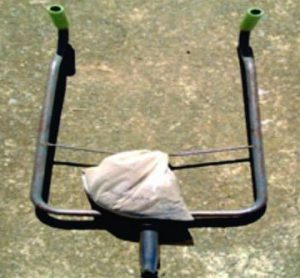
IMPORTANCE OF SOIL SAMPLING FOR INCREASED CROP YIELDS
As farmers prepare for the next planting season, there are key things that have to be observed in order to have great yields at the end of the season. It has been always for every farmer to know the suitability of crops or vegetables before attempting to plant. This information is valuable as every farmer’s dream is to maximise profit and minimise loss.
The Department of Rural Development and Agrarian Reform has experts who assist farmers from time to time to achieve this. According to Zolani Mkile, a Soil Scientist based in Dohne Agricultural Development Institute where a team of researchers in various agricultural fields operates form,
“South African soils are extremely deficient in major nutrients especially phosphorus (P), potassium (K), nitrogen (N). Maize deficient symptoms of these macronutrients are shown in photo 1 below. These nutrient deficiencies can be corrected by addition of fertilizers (organic or inorganic) after following correct soil sampling procedures. “The importance of soil sampling procedures cannot be over emphasised in soil analysis programme.
It is well known that the sampling error is generally greater than the error in a laboratory analysis. It must be taken into account that usually a 2.5 g subsample of soil taken from a 500 g soil sample (from 15 cm depth) represents a 2.5 ha field. It also represents less than 1 billion (1x 109) of the total soil volume for which the analysis is carried out.
Therefore, the value of soil testing depends on how carefully the soil sample is taken. A poor soil sample is usually worse than none at all because the results are misleading. The best soil sampling procedure takes into consideration correct soil sampling equipment,
Sampling area, number of cores (subsamples), sampling pattern, sampling depth, time and frequency of sampling.
Soil sampling equipment A Beater soil sampler (photo 2) is a pre-requisite for obtaining high quality soil sample. It is not advisable to use other soil sampling tools like “screw in “type of augers, spades or towels for taking topsoil samples. The problem with the latter type of samplers is that it is difficult to obtain sufficient number of subsamples.
Sampling materials when taking soil samples, it is of utmost importance to use clean plastic bags and standard soil sample (box) cartoon (400 g). Please take note, contaminated fertilizer bags, milk containers, cement containers, baby milk formula containers, maize meal containers, oil tins, and tins with rust and contaminated shopping plastic bags.
Sampling area the size of area of which a composite sample can be taken away varies from a small garden plot to the field of 20 ha or more. The following guidelines should be taken into account when deciding on areas to be sampled: a) the sample should represent one soil type. When sampling a large field with different soil types, separate samples should be taken for different soil types. b) The field to be sampled should be subdivided based on cropping or fertilization histories. That is, each area that has been cropped or fertilized differently should be sampled separately. c) Edges of a field or garden that may have lime or fertilizer spills, localized poor drained areas within a field must be avoided. If such areas are large, they need to be sampled and fertilized separately. d) Patches in the land where plant growth is poor and showing localized fertility problems need to be samples whilst the crop is still on the land. Once the crop is removed from the land, it becomes impossible to identify such areas.
Sampling depth The sampling depth for row crops such as maize, beans, pumpkins, sorghum, vegetables as well as pasture establishment is 15 cm. For established pastures the sampling depth is 10 cm. The reasons for different sampling depth are: They represent the soil zone in which maximum Subsoil acidity is a constraint in crop and pasture production. Therefore, in order to take subsoil samples, the long soil auger including “screw in “type of augers is recommended. The usual practice is to take depth samples at several localities in the field with separate samples being collected at 20 cm increments down the profile to a depth of 1 m.
Sampling pattern For both top and subsoil samples, a representative soil sample is obtained by taking 20 to 40 subsamples (cores) in a zig-zag patternnutrient uptake occurs for such crops. Such depths are used in field calibration trials, which form the basis of fertilizer recommendations. If someone is taking soil sample for maize, choose 30 cm depth, and base his or her fertilizer recommendations on such norms, these will result in over-fertilization. The maintenance of a constant sampling depth is accomplished with a Beater sampler (auger) since it cannot be pushed dipper than its crossbar.
Mixing for composite soil sample The composite sample obtained must be thoroughly mixed and a portion is used to fill standard soil sample (box) cartoon (400 g) or clean plastic bag that will fit 400 or 500g of soil.
Time and frequency of sampling. It is always preferable to sample soil after tillage (in June), especially where fertilizers have been band-placed. In order to facilitate timely ordering of fertilizers for the following season, soil sampling should be carried out sometime before planting the intended crop or pasture.
Liming It should be borne in mind that where acidity is a problem, it is necessary to incorporate lime 4 to 6 weeks before planting in order to allow neutralization reaction to take place.

